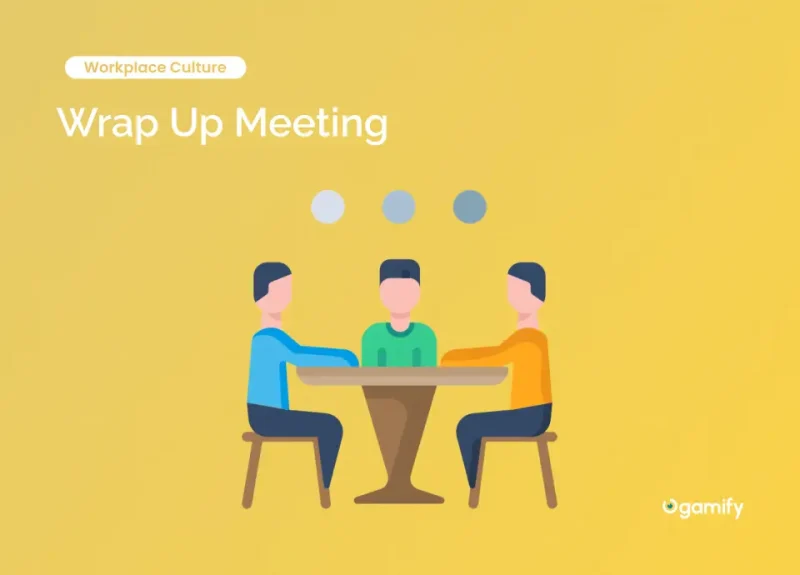In the fast-paced world of business, meetings play a vital role in collaboration, decision-making, and project management. Among these meetings, the wrap-up meeting holds great significance as it allows teams to reflect on their progress, discuss key takeaways, and plan for future actions. However, conducting an effective wrap-up meeting requires careful planning and execution. In this article, we will explore various strategies that can help you make the most out of your wrap-up meetings, ensuring productivity, engagement, and clear communication.

Importance of Wrap Up Meetings
Wrap-up meetings serve as a platform for teams to reflect on their accomplishments, review project objectives, and discuss lessons learned. These meetings provide closure to projects or important phases, allowing team members to celebrate successes, evaluate challenges, and identify areas for improvement. A well-executed wrap-up meeting sets the stage for future projects and ensures that valuable insights are captured and shared.

How to Prepare for a Successful Wrap Up Meeting?
To conduct an effective wrap-up meeting, adequate preparation is essential. Start by reviewing the project objectives, milestones, and any supporting documentation. Identify key stakeholders and invite them to the meeting, ensuring their availability. Consider sending out a meeting agenda in advance, detailing the topics to be discussed, and requesting participants to come prepared with their inputs and feedback.
Start of the Meeting
The opening of a wrap-up meeting sets the tone for the entire session. Begin by acknowledging the team’s hard work and expressing appreciation for their contributions. Recap the project’s objectives, emphasizing the achievements and milestones reached. Encourage open and honest communication, and remind participants of the meeting’s purpose: to reflect, learn, and plan for the future.

Facilitating Effective Discussions
Establishing the Meeting Agenda
A well-defined agenda is crucial for a productive wrap-up meeting. Break down the discussion points into specific topics or sections, allocating sufficient time for each. Ensure that the agenda covers all relevant aspects, such as project outcomes, challenges faced, key learnings, and future recommendations. Share the agenda beforehand to allow participants to prepare and contribute effectively.
Encouraging Active Participation
Active participation is vital to gather diverse perspectives and ensure everyone’s input is heard. Encourage attendees to share their thoughts, insights, and recommendations. Utilize open-ended questions to stimulate discussion and engage participants. Create a supportive and inclusive environment where everyone feels comfortable expressing their opinions.
Managing Time and Stay on Track
Time management is crucial during wrap-up meetings to cover all agenda items effectively. Set clear time limits for each discussion point and remind participants to adhere to them. Appoint a facilitator or meeting chairperson responsible for keeping the meeting on track, ensuring that discussions remain focused and productive.

Documenting Meeting Outcomes and Action Items
To make the wrap-up meeting meaningful and actionable, document the meeting outcomes and action items. Assign responsibilities for each action item, along with clear deadlines. Use collaborative tools or project management software to track progress and keep everyone informed. Distribute meeting minutes or a summary afterward, capturing the key decisions, action points, and next steps.
Ensuring Follow-up and Accountability
Follow-up is crucial to ensure that the action items discussed during the wrap-up meeting are implemented effectively. Monitor progress regularly and provide support where needed. Encourage team members to take ownership of their assigned tasks and maintain accountability. Regularly communicate updates and milestones achieved, keeping the team engaged and motivated.
Utilizing Technology for Enhanced Wrap Up Meetings
Leveraging technology can enhance the effectiveness of wrap-up meetings. Utilize video conferencing tools for remote team members or distributed teams. Collaborative platforms enable real-time document sharing and collaboration, ensuring everyone has access to relevant information. Consider using online survey tools to collect anonymous feedback to promote transparency and address concerns.

Additional Meeting Wrap Up Activities
Apart from discussions and documentation, incorporating additional wrap-up activities can add value and make the meeting more engaging. These activities may include team-building exercises, knowledge sharing sessions, or recognition ceremonies to acknowledge outstanding contributions. Tailor these activities to your team’s preferences and the nature of the project.
Project Evaluation and Celebration
The final wrap-up meeting marks the completion of a project or a significant phase. It is an opportunity to evaluate the project’s overall success, review the impact on business objectives, and celebrate achievements. Reflect on lessons learned, both positive and negative, to carry forward valuable insights to future endeavors. Recognize and appreciate the team’s efforts, fostering a positive workplace culture.
Conclusion
Effective wrap-up meetings are instrumental in ensuring project success and continuous improvement. By following the strategies outlined in this article, you can conduct wrap-up meetings that engage participants, drive valuable discussions, and leave a lasting impact. Remember to set the stage with a strong opening, encourage active participation, document outcomes, and follow up on action items. By implementing these practices, you can maximize the benefits of wrap-up meetings and contribute to a thriving workplace culture.
FAQ
What is the purpose of a wrap-up meeting?
A wrap-up meeting serves the purpose of reflecting on project accomplishments, discussing lessons learned, and planning for the future. It provides closure to projects and helps identify areas for improvement.
How long should a wrap-up meeting be?
The duration of a wrap-up meeting depends on the project’s size and complexity. Typically, it can range from 1 to 2 hours. However, ensure that sufficient time is allocated to cover all essential discussion points.
Should everyone be involved in a wrap-up meeting?
Ideally, all key stakeholders and team members involved in the project should be part of the wrap-up meeting. Their perspectives and insights contribute to a comprehensive evaluation and facilitate future planning.
Can a wrap-up meeting be conducted remotely?
Yes, wrap-up meetings can be conducted remotely using video conferencing tools and collaborative platforms. Ensure that all participants have access to the necessary technology and a stable internet connection.
How can wrap-up meetings contribute to team building and workplace culture?
Wrap-up meetings provide an opportunity to acknowledge individual and team achievements, fostering a positive workplace culture. They encourage open communication, collaboration, and reflection, which contribute to team building and a sense of shared accomplishment.

